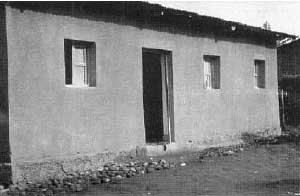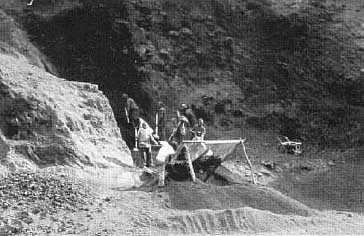Pozzolanas - Calcined Clays and Shales, and Volcanic Ash - Technical Brief
Contents
Short Description
- Problem: Low-Cost Alternative to Portland Cement
- Idea: Use Pozzolanas instead of Portland Cement
- Information Type: Application
Pozzolanas are materials containing reactive silica and/or alumina which on their own have little or no binding property. However, when mixed with lime, in the presence of water, they will set and harden like cement. Pozzolanas are an important ingredient in the production of alternative binding materials to Portland cement (OPC). Alternative cements provide an excellent technical option to OPC at a much lower cost and have the potential to make a significant contribution towards the provision of low-cost building materials and consequently affordable shelter.
Pozzolanas can be used in combination with lime and/or OPC. When mixed with lime, pozzolanas will improve the properties of lime-based mortars, concretes and renders for use in a wide range of building applications. Alternatively, they can be blended with OPC to improve the durability of concrete and its workability, and reduce its cost considerably.
A wide variety of siliceous or aluminous materials may be pozzolanic, and historically the two most widely used of these are calcined clays and volcanic ash. Calcined clay in the form of crushed fired clay bricks, tiles or pottery has traditionally been used for improving the properties of lime mortars and renders. (It is known as surkhi in India, homra in Egypt and semen merah in Indonesia.) Shales are harder than clays and have similar mineral contents resulting in similar pozzolanic properties.
Volcanic ash was first used as a pozzolana by the Romans from deposits close to the village of Pozzuoli, near Naples, hence the name.
Clays and shales
Clays or shales suitable for use as a pozzolana are very widespread and are readily available in almost all regions of the world. They have been used as cement replacement materials on large-scale construction programmes in a number of countries, particularly the US, Brazil, Egypt and India. For example, in Egypt, a lime-calcined clay mortar was used in the core of the first Aswan dam built in 1902 and an OPC-calcined clay mixture was used in the construction of the Sennar dam in Sudan.
However this large-scale utilization has declined in the last three decades, due to the availability of pozzolanas which require less processing and are therefore cheaper, such as volcanic ash and pulverized fuel ash. Where these are not available, the use of calcined clay still has considerable potential. Although sandy clays are often used as a pozzolana, frequently in the form of crushed fired clay bricks, the coarser sand is not reactive. The pozzolanic activity resides in the finer clay mineral fraction, and sandy clays may not produce the best pozzolanas. Despite their variable pozzolanic performance, the use of ground underfired or reject bricks and tiles as a pozzolana is likely to continue on a small scale due to the low cost of these waste materials.
Plastic clays, as used in tile manufacture or for pottery, can produce better pozzolanas, although the composition of good pozzolanic clays is variable. Table 1 gives the chemical composition (on an oven-dry basis} of some clays in India which produce pozzolanas conforming to the Indian Standard for calcined clay pozzolana (IS 1344.1981).
|
Constituents |
Contents by weight |
|
Silica + Alumina + Iron Oxide |
Not less than 70% |
|
Silica |
Not less than 49% |
|
Calcium Oxide |
Not more than 10% |
|
Magnesium Oxide |
Not more than 3% |
|
Sulphur trioxide |
Not more than 3% |
|
Water soluble alkali |
Not more than 0.1% |
|
Water soluble material |
Not more than 1% |
|
Loss on ignition |
Not more than 10% |
Table 1. Chemical composition of clay suitable for use in calcined clay pozzolanas
Raw materials for calcined clay pozzolanas should be free from coarse sand or gravel greater than about O.6mm in diameter.
In tropical climates, clay deposits are often subjected to a form of chemical weathering which leaches out the silica and alkalis resulting in a accumulation of ferric and aluminium hydroxides. The soils produced are bauxitic (aluminium bearing) and lateritic (iron bearing). Although these soils are low in silica, normally considered essential for a pozzolanic reaction, both will exhibit some pozzolanic reactivity when calcined. In general, the reactivity of laterite is low but bauxite can show reasonable results and its use as a pozzolana should be considered if silica-bearing clays are not available.
Processing of calcined clays and shales
Calcining
The early stages of processing calcined clay pozzolanas are similar to the moulding and firing process for clay bricks, tiles or pottery, and traditionally the rejects from these industries have been used as pozzolanas. The optimum calcining temperatures for clay pozzolanas are slightly below those for clay bricks or tiles and therefore better results are likely to be obtained if the moulding and firing process are designed specifically for pozzolana production. The Indian Standard (IS1344 1981) gives the following range of temperatures for different types of clays:
|
Montmorillonite type |
600 to 800°C |
|
Kaolinite type |
700 to 800°C |
|
Illite type |
900 to 1000°C |
In practice, most clay soils consist of a mixture of minerals, and a calcination temperature of 700-800°C is normally considered suitable. The optimum period of calcination will vary with clay type but is normally around one hour or less.
Rotary kilns have been the most common means of calcining clays and have been extensively used in the US and Brazil. Natural gas or oil is normally used as a fuel and outputs vary from 12.5 to 100 tonnes per day.
Several Indian institutions, including the Central Road Research Institute and the National Building Organization, have undertaken studies to design and test kilns specifically for clay pozzolana production with production rates of between 5 and 20 tonnes per day. Two of the kilns are coal fired and are designed on the natural down-draught and forced air vertical shaft concepts similar to those commonly used, respectively, in the ceramics and lime industries.
A third kiln utilizes the fluidized bed system. Dried and pulverized clay is allowed to fall through a series of fins against an updraft of hot gases generated by oil burners. Although the contact time is extremely short, of the order of a few minutes, it is apparently sufficient to calcine the ground clay feed. The cost of production, despite the cost of using oil as a fuel, is reported to be competitive with other methods.
Grinding
The second step in processing is the grinding of the calcined clay to a fine powder. On a small scale, this has traditionally been performed with human or, more commonly, animal-powered methods. Ball mills are more suited to large-scale applications. Some calcined clays, such as kaolin, will be softer than others and will therefore require less grinding in order to achieve the desired fineness.
Volcanic ash
Deposits of volcanic ash are likely to be found wherever there are active or recently active volcanos, for example in the Mediterranean, the Pacific region, and central and eastern Africa. The physical condition of volcanic ashes may range from loose fine material to coarse deposits containing quite large particles. Deposits may be loose, with an appearance and texture similar to a compacted coal or wood ash. Other deposits are cemented, sometimes with appearance and properties similar to stone, and in this form they are normally referred to as tuffs or trassy. The colour of deposits can vary from off-white to dark grey.
|
Constituents |
Contents by weight |
|
Silica |
45-65% |
|
Alumina + Iron Oxide |
15-30% |
|
Calcium + Magnesium Oxide + alkalis |
Up to 15% |
|
Loss on ignition |
Up to 12% |
Table 2. Composition of volcanic ash suitable for use as a pozzolana
The pozzolanic reactivity of ash deposits can vary considerably. The quality of material may also vary within a single deposit or a single geologically consistent stratum, with variations in depth being common.
Regular testing is therefore required if volcanic ash is to be used as a pozzolana and this has been a constraint to its commercial exploitation. However, volcanic ash is, or has recently been, successfully used as a pozzolana in many countries including the US, Germany, Japan, Italy, Kenya and Indonesia, with pilot plants tested in Tanzania and Rwanda. For example, 200,000 tonnes of volcanic pozzolana were used in the construction of the Glen Canyon dam in the US, completed in 1964.
Volcanic pozzolanas usually have chemical composition within the limits shown on table 2.
Processing of volcanic ash
Once the deposits have been excavated most volcanic ashes will require only minor processing before use as a pozzolana. Many ashes are only loosely cemented and can easily be excavated by hand, although others may need mechanical or pneumatic equipment.
Some lithic tuffs may require blasting with explosives. The ash may require drying, and in dry sunny climates this can simply be achieved by spreading the ash in a thin layer on a specially prepared drying floor, similar to those commonly used to dry crops. Alternatively, in wet climates, and for large quantities, inclined rotary driers are normally used.
If the ash is cemented it will need to be crushed before entering the dryer. Some volcanic ashes will already be in a very fine, loose powdered form and may not require crushing or grinding. Other ashes may be of sufficient fineness but be cemented together. These will require milling or crushing. Coarse ashes and lithic tuffs will need to be ground in a ball mill or similar.
Utilization of pozzolanas
A fineness similar or slightly greater than that of OPC is usually recommended for pozzolanas although some have been ground considerably finer. The minimum fineness recommended by the Indian standards for pozzolana (IS 1344. 1981. Calcined clays) is 320 and 250m2/kg for grade 1 and 2 pozzolanas respectively, measured by the Blaine air permeability test.
Once the pozzolana has been ground, it must be blended with lime and/or OPC to produce a pozzolanic cement. This can be accomplished by human or animal-powered methods but full homogeneity is unlikely to be achieved and the strength and consistency of cements blended in this manner will be variable. Mechanical techniques, preferably intergrinding in a ball mill or, as a second option, dry blending in a pan or concrete mixer, will give better results in terms of both strength and consistency.
Pozzolanas can be used with either lime and/or OPC. With the latter, replacement of up to 25-30% is common, although research has suggested that for non-structural purposes replacement of up to 50% can be used. With lime pozzolana cements mixtures of 1:1 to 1:4 (lime:pozzolana) by weight are used. The addition of 5-10% of OPC will improve strength and decrease setting times. A larger percentage of OPC may be required if only poor quality pozzolanas are available. The exact ratio of the ingredients will depend upon the quality of the respective raw materials and on the required characteristics of the concrete or mortar made from the cement.
A good calcined clay or volcanic ash pozzolana should produce a cement, when mixed with a good quality lime, capable of producing concretes and mortars with 7 and 28 days strengths in excess of 2 and 4 mega pascals (MPa) respectively. Pozzolana strength development is slow and long-term strengths should be considerably higher, as much as 15MPa by 2 years.
Strength development can be accelerated if up to 4 per cent of fine gypsum is added to the lime-pozzolana mix.
Other leaflets in this series deal in more detail with the production, properties and utilization of pozzolana cements, and with testing and performance standards.
References and further reading
Testing Methods of Pozzolanas Practical Action Technical Brief
Pozzolanas: Rice Husk Ash and Pulverised Fuel Ash Practical Action Technical Brief
Pozzolanas: Lime-Pozzolanas Cements Practical Action Technical Brief
Pozzolanas: Portland - Pozzolanas Blended Cements Practical Action Technical Brief
Appropriate Building Materials, R. Stulz, and K. Mukerji, co-published by ITDG Publishing, SKAT and GATE, 1993.
The Chemistry of Cement and Concrete, F.M. Lea, Edward Arnold, London, 3rd Edn, 1970.
Building Materials in Developing Countries, R.J.S. Spence, and D.J. Cook, John Wiley & Sons, New York,1983.
Cement Replacement Materials. R.N. Swamy, R.N. (Ed.), Surrey University Press/Blackie & Sons, 1986.
Small-scale Production of Cementitious Materials, R.J.S. Spence, IT Publications, London, 1980.
Specification for Calcined Clay Pozzolana (2nd revision), Indian Standard IS 1344: 1981,
Bureau of Indian Standards, New Delhi, India, http://www.bis.org.in/
Useful addresses
Practical Action
The Schumacher Centre for Technology & Development, Bourton on Dunsmore, RUGBY, CV23 9QZ, United Kingdom.
Tel.: +44 (0) 1926 634400, Fax: +44 (0) 1926 634401
e-mail: practicalaction@practicalaction.org.uk
web: www.practicalaction.org

Categories
- Global Technology
- Construction
- Ideas
- Products
- Recycling
- Small Business
- Soil
- Waste
- Difficult
- Medium
- Global
- Mediterranean Climate
- Monsoon Climate
- Montaneous Environment
- Rural Environment
- Temperate Climate
- Tropical Climate
- Urban Environment
- Ashes
- Fly Ash
- Coal
- Lime
- Cement
- Rice Husk
- Bricks
- Pozzolanas
- Application
- Principles
- Howtopedia requested drawings
- Howtopedia requested images
- Requested translation to Spanish
- Requested translation to French

